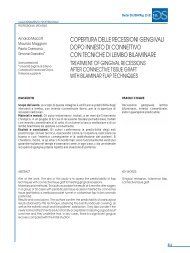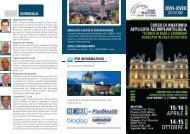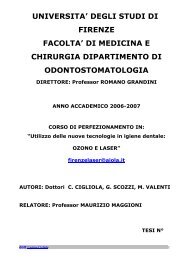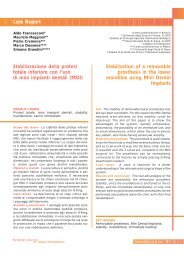LASER E SBIANCAMENTO - Maurizio Maggioni
LASER E SBIANCAMENTO - Maurizio Maggioni
LASER E SBIANCAMENTO - Maurizio Maggioni
You also want an ePaper? Increase the reach of your titles
YUMPU automatically turns print PDFs into web optimized ePapers that Google loves.
the critical value of 5.5 degrees C. Available studies do not allow for a final judgment whether<br />
tooth whitening can either be increased or accelerated by additional activation.<br />
CONCLUSION: Therefore, application of activated bleaching procedures should be critically<br />
assessed considering the physical, physiological and patho-physiological implications.<br />
PMID: 16820199 [PubMed - indexed for MEDLINE]<br />
Br Dent J. 2006 Jun 10;200(11):631-4; discussion 619<br />
Surface and pulp chamber temperature rises during tooth<br />
bleaching using a diode laser: a study in vitro.<br />
Sulieman M, Rees JS, Addy M.<br />
Division of Restorative Dentistry, Department of Oral & Dental Science, University of Bristol Dental<br />
School, Lower Maudlin Street, Bristol, BS1 2LY. m.sulieman@bristol.ac.uk<br />
OBJECTIVE: To measure the surface and pulp chamber temperature increases in vitro on upper<br />
and lower anterior teeth during a tooth whitening procedure using a diode laser.<br />
METHOD: A thermocouple was used to measure the temperature increase on the surface of an<br />
extracted upper central incisor tooth. Pulp chamber temperature readings were made on upper<br />
and lower central incisors, lateral incisors and canines. A diode laser recommended for tooth<br />
bleaching was tested at three different power settings (1W, 2W, 3W). Temperature measurements<br />
were made with and without the bleaching agent present on the labial tooth surface.<br />
RESULTS: The increase in surface temperature readings ranged from 37 degrees C (1W) to 86.3<br />
degrees C (3W) with no bleaching gel present. Pulp chamber temperature increases ranged from<br />
4.3 degrees C (1W) to 16 degrees C (3W). The presence of the bleaching gel reduced temperature<br />
increases seen at the tooth surface and within the pulp.<br />
CONCLUSIONS: The increase in the pulp chamber temperature with the laser used at 1-2W was<br />
below the critical temperature increase of 5.5 degrees C thought to produce irreversible pulpal<br />
damage. However, a power setting of 3W produced a pulp chamber temperature increase above<br />
this threshold (16 degrees C) and caution is advised when using this setting.<br />
PMID: 16767142 [PubMed - indexed for MEDLINE]<br />
Influence of fluorescence-controlled Er:YAG laser radiation,<br />
the Vector system and hand instruments on periodontally<br />
diseased root surfaces in vivo.<br />
Schwarz F, Bieling K, Venghaus S, Sculean A, Jepsen S, Becker J.<br />
Department of Oral Surgery, Heinrich Heine University, Dusseldorf, Germany. info@frankschwarz.de<br />
2004<br />
OBJECTIVES: The aim of the present study was to evaluate the effects of fluorescence-controlled<br />
Er:YAG laser radiation, an ultrasonic device or hand instruments on periodontally diseased root<br />
surfaces in vivo.<br />
MATERIAL ANDMETHODS: Seventy-two single-rooted teeth (n=12 patients) were randomly<br />
treated in vivo by a single course of subgingival instrumentation using (1-3) an Er:YAG laser<br />
dott Cosimo Cigliola 152






